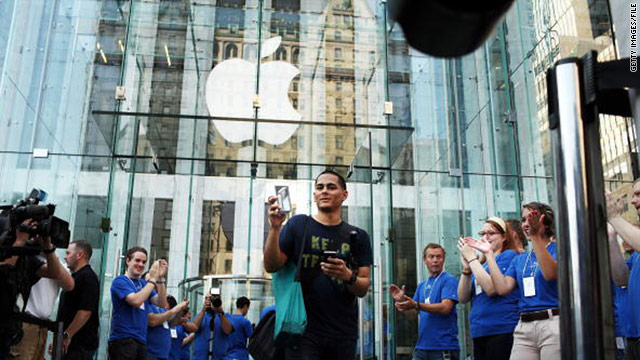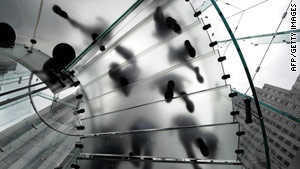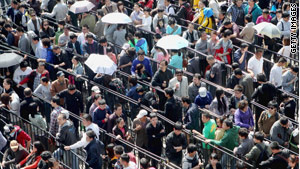
It started with one store at Tysons Corner Center in Virginia, just outside of Washington.Ten years and more than 300 stores later, it's become a retailing venture unique in the world of consumer electronics.The Apple retail store, the stylized and shiny public face of the Cupertino, California-based gadget giant, turns 10 on Thursday. It's a marketing strategy that few other companies could pull off, analysts say -- one powered as much by Apple's heralded (some would say overhyped) focus on style and presentation as by its products themselves. But as the 2000s were just dawning, it was far from a sure thing.
"Around the time Apple started to roll out, Gateway's products were going the other way," said Adam Hanft, CEO of marketing and branding firm Hanft Projects, referring to the PC makers (they of the cowhide-designed boxes) who eventually gave up on their own retail-store model in 2004.
"If you go back and look at what all the pundits said, they all thought Apple was crazy to get into the retailing business."
Until then, the consumer technology model was fairly well set. Hardware manufacturers made computers and other gadgets, which were sold alongside their competitors at electronics and big-box retail stores. Picking up the cost of overhead, and gambling that shoppers would patronize a store with only one company's products, was considered risky.
A decade of growth
By the end of the 2010 fiscal year, Apple had opened 317 retail stores, 233 in the United States and 84 in Europe, Asia and other countries, according to Ticonderoga Securities, which studies the company.
Apple stores across the world host long lines of acolytes -- er, shoppers -- with the retail launch of every high-profile new gadget, such as an iPhone or iPad. The stores earned roughly $3.2 billion, about 13% of Apple's total sales, in 2010, Ticonderoga said.
The model works, Ticonderoga analyst Brian White says, because it's an extension of Apple's overall model of keeping tight reins on their products and their image.
Shoppers navigate a staircase at Apple's Fifth Avenue store in New York, which is a big glass cube.
"Apple, as you know, likes to control their environment -- they do it with their PCs and other products ... because they think they can do it better," he said. "The stores look the same. They feel the same. They're generally in the same type of upscale areas. You can control the quality and the experience."
Some Apple stores, such as the flagship New York City store on Fifth Avenue, are even design symbols in themselves. That one, open 24 hours a day, is a distinctive 32-foot glass cube.
Apple declined a request to speak with someone for this article. A spokeswoman would not say earlier this week what, if any, plans Apple had to commemorate Thursday's anniversary and would not provide any Apple documentation about the history of the stores.
The company seems to definitely have something brewing, however.
Multiple reports have retail employees planning overnight shifts in advance of the anniversary, and black barriers arriving to hide ... well ... something.
The first store
In a 2000 video shown to Apple developers, CEO Steve Jobs strolls through the as-yet-unopened Virginia store, showcasing then-novel features such as the Genius Bar and nooks for children's activities.
With nary an iPod or iPhone in sight (the iPod was launched in October that year, with the iPhone following in 2007), Jobs introduced the concept that the stores would be more than just retail space.
"Literally half the store is devoted to solutions," Jobs says in the video. "Because people don't just want to buy personal computers any more. They want to know what they can do with them."
Then, Hanft said, there's the intangible appeal.
"People will almost invent reasons to go there," he said. "Apple is closer to a fashion aesthetic than a tech aesthetic. You walk in, and you would think it's closer to Prada than it is to Radio Shack."
The opening of that first Apple store was greeted with the zeal that's become commonplace when new Apple products are released.
"I went to this rave last night and had all this extra energy, so I decided to come here," Chris Barylick, who was first in line after showing up six hours before the store opened,told tech blog CNETat the time.
Praise, criticism and "The Simpsons"
For Apple critics (and what critics attack their prey more lustily than Apple's?), that's the point. They say the stores are merely clubhouses catering to Apple fans' blind loyalty to the company.
"If you don't believe me, go into an Apple store," Simon Mills of London's Daily Mail wrote last year in a sweeping anti-Apple piecetitled "Why I hate Apple, the infuriating cult making people smug bores."
"You will hear very little conversation and absolutely no laughter at all. Instead, you'll see lines of cult followers passively standing in front of screens, their faces riddled with the anxiety and discomfort of someone terrified they are behind the technological times."
Even "The Simpsons" took some jabs when the animated family paid a visit to the "Mapple Store."
"It's so sterile!" a starry-eyed Lisa exclaims as she enters. Homer marvels at a "myCube," a glowing device "fueled by dreams and powered by imagination," according to the haughty employee behind the "Brainiac Bar."
"What does it do?" Homer asks. The employee's response: "You should ask yourself, 'What can I do for it?' "
People line up outside an Apple store in Beijing, China, earlier this month to buy an iPad 2.
Analysts predict that as long as Apple maintains steady, targeted growth with the stores, they'll continue to succeed with them. Emerging markets such as China, India and Brazil are obvious next steps.
"It's only going to get bigger," said White, who travels regularly to China and said "Apple fever" got hot in earnest there with the release of the iPad.
Hanft agrees, as long as Apple sticks to the model that's worked so far.
"They could get greedy. They could move into markets that can't support them. That's the risk."
He also said that if "brand dictator" Jobs became less involved, someone at the company could decide to put other products in the store (now, it's just Apple and a handful of approved accessories). That, Hanft said, could water down the stores' appeal.
But, at least for now, he expects the surprise success to continue into the next decade.
"You have to give them credit for not just defying the skeptics, but basically creating a new retail model," he said.




